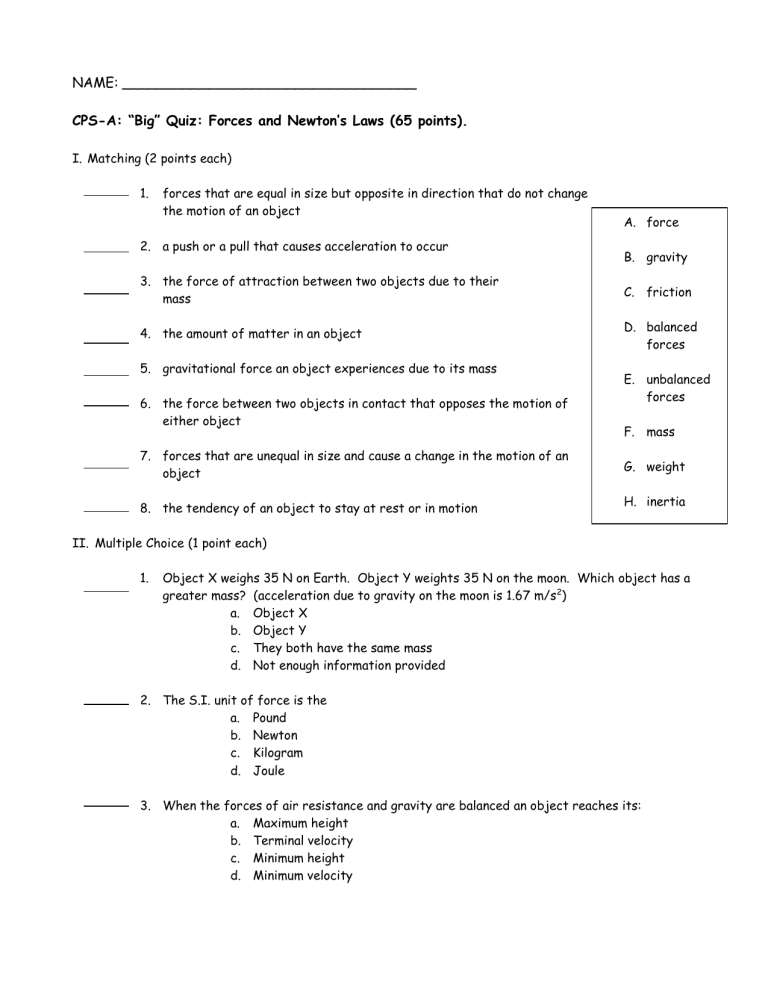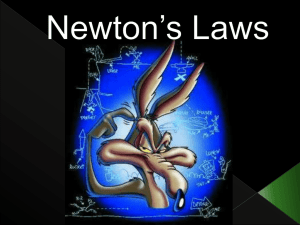quiz newtons 2.25.2019
advertisement

NAME: __________________________________ CPS-A: “Big” Quiz: Forces and Newton’s Laws (65 points). I. Matching (2 points each) 1. forces that are equal in size but opposite in direction that do not change the motion of an object 2. a push or a pull that causes acceleration to occur A. force B. gravity 3. the force of attraction between two objects due to their mass C. friction 4. the amount of matter in an object D. balanced forces 5. gravitational force an object experiences due to its mass 6. the force between two objects in contact that opposes the motion of either object 7. forces that are unequal in size and cause a change in the motion of an object 8. the tendency of an object to stay at rest or in motion E. unbalanced forces F. mass G. weight H. inertia II. Multiple Choice (1 point each) 1. Object X weighs 35 N on Earth. Object Y weights 35 N on the moon. Which object has a greater mass? (acceleration due to gravity on the moon is 1.67 m/s 2) a. Object X b. Object Y c. They both have the same mass d. Not enough information provided 2. The S.I. unit of force is the a. Pound b. Newton c. Kilogram d. Joule 3. When the forces of air resistance and gravity are balanced an object reaches its: a. Maximum height b. Terminal velocity c. Minimum height d. Minimum velocity III. Short Answer (2 points each) 1. State Newton’s three laws of motion. i. 1st: ii. 2nd: iii. 3rd: 2. Which Law? Determine which of Newton’s Laws explains the scenarios given below. Write 1st, 2nd, or 3rd in the spaces to the right. (1 point each) i. As the fuel in a rocket engine ignites, the force of the gas expansion and explosion pushes out the back of the rocket and pushes the rocket forward. ii. Subway cars provide posts and overhead rails for standing passengers to hold. iii. It takes longer for a boat to accelerate when it has 10 passengers instead of 2 passengers. iv. A pitched baseball goes faster than one that is gently thrown. v. A little girl who has been pulling a sled behind her in the snow is crying because when she stopped to tie her shoe the sled kept moving and hit her in the back of her legs. vi. A swimmer pushes water back with her arms, but her body moves forward. 3. Choose two of the scenarios from #2 above and explain how each is an example of Newton’s laws. (4 points) d = vit + 1/2gt2 g = 9.8 m/s2 v = gt F = ma w = mg IV. Calculations. SHOW ALL WORK! 1. An acorn at rest falls from an oak tree. The acorn hits the ground with a velocity of 14.7 m/s. i. How long did it take the acorn to land? (2 points) ii. How high off the ground was the acorn before it fell? (2 points) 2. A car has a mass of 1550 kg and is out of gas! A man pushes the car and it moves with an acceleration of 0.156 m/s2. Determine how much force was applied by the man. (4 points) 3. A 7.5 kg object is weighed on a spring scale on the surface of the planet Nerdo. i. If the scale reads 78.4 N, what is the acceleration due to gravity on Nerdo? (2 points) ii. What would the objects mass be on Earth? (2 points) iii. What would the objects weight be on Earth? (2 points) 4. A wagon is pulled with a force of 20 N to the right, and pushed by the wind with a force of 15 N to the left. i. Draw a free-body diagram of this situation. (2 points) ii. What is the net force acting on the wagon (magnitude and direction) (2 points) iii. If the wagon accelerates at a speed of 0.5 m/s2, what is its mass in kg? (2 points) V. 1. YOU MUST ANSWER 2 OF THE FOLLOWING 3 QUESTIONS. YOU MAY ANSWER THE 3 RD FOR EXTRA CREDIT. (5 points each) A rocket is launched upward moving at a constant velocity. The gravitational force, exerted by Earth on the rocket, is 900 N downward. i. What must be the net force that acts on the rocket? Why? U S A ii. What must be the magnitude and direction of the second force that pushes on the rocket? iii. What object exerts this force? 2. The graph below shows the velocity vs. time graph of a car traveling on a straight highway. The mass of the car is 500 kg. i. What is the acceleration of the car? iii.What force would be required for a car with twice the mass to exhibit the same velocity vs. time graph? velocity (m/s) ii.What is the magnitude of the net force on the car? Velocity vs. Time of a Car 90 80 70 60 50 40 30 20 10 0 0 10 20 time (s) 30 3. A tiny bug hits the windshield of a car traveling at 65 km/hr. i. Which object experiences the greater force? Explain your answer. ii. With Newton’s 2nd Law of Motion in mind, which object experiences the greater acceleration? Show proof. 40





